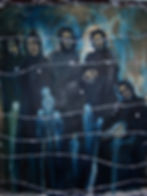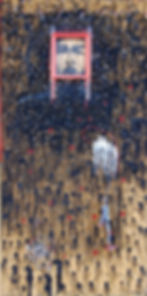This project has been long and painful. It has been the work of four years researching cruelty of man in diverse manifestations: genocide, concentration camps, kidnapping, guerrilla warfare, terrorism and torture among others. A world of horror without an end.
The main reasons for this project are my need to express a reality and a wish to create hope for us so we can live without violence and in peace."
Gustavo Duque






Rails at Crimes against Humanity
“All Changes, even the most longed for, have their melancholy; for what we leave behind us is a part of ourselves; we must die to one life before we can enter
another.” This observation, made by the Gallic poet, novelist, critic and Nobel laureate, Anatole France, resonates in Gustavo Duque’s provocative series of
new work.
It represents a radical departure for the Colombian-born painter. It also captures his searing analysis of the uncertainty permeating contemporary society.
Not unlike Goya observing the sleep of reason, Duque remains committed to exploring the tortured history of social injustice. He continues producing complex,
powerful works embedded with a thoughtful, dark intelligence, sense of irony and a healthy skepticism that eschews heavy-handed references.
Present in these large-format paintings are ominous chromatic ranges and an atmospheric unease typical of his familiar brand of moody, existentialist imagery.
Duque’s mastery of nuanced expressiveness remains notable in harrowing war and terrorist scenes. As before, in his earlier desolate landscapes populated
by forlorn, anonymous figures, the artist maintains full control of the ambiance.
In this austere series of works, Duque clusters knots of war and crime-ravaged souls within a harsh, withering light. Duque’s spectral figures, dramatically
rendered with loose, gestural brush strokes in tarry black specks against bold swaths of spilled blood-red hues, exude an aura of mystery and appear to float
in a vacuum.
In several pieces, the mournful flicker of shadows seeps into his unforgiving palette. Often he superimposes images, evoking the impression of chaos or the
exploration of three-dimensionality. His canvases seem to unveil paintings within paintings, offering a visual translation of the rippling echoes of time and
conveying the notion of loss filtered through the worn gauze of memory. These scenes appear as if issued from an unsettling reverie.
Duque suggests that an unstructured brutality and ugliness consumes our society. He accomplishes this by ratcheting up the IV drip of tension among his
nameless protagonists. Rather than offering solutions to these problems, Duque’s work invites the viewer to draw their own conclusions regarding society’s ills.
In works such as Nightmare, Powerless and The Power of Terror, the artist confronts the spectator as a chronicler of the bleak fringes of the human condition.
He evokes an intense image of anxiety or the aftermath of a terrible calamity.
With these commanding and enigmatic paintings Duque reaches a new level of achievement in formal abstract terms. He does so without diminishing the
power of his ongoing themes or surrendering his hope for a better world.
Irreversible, An International Art Project Magazine, December 2010
